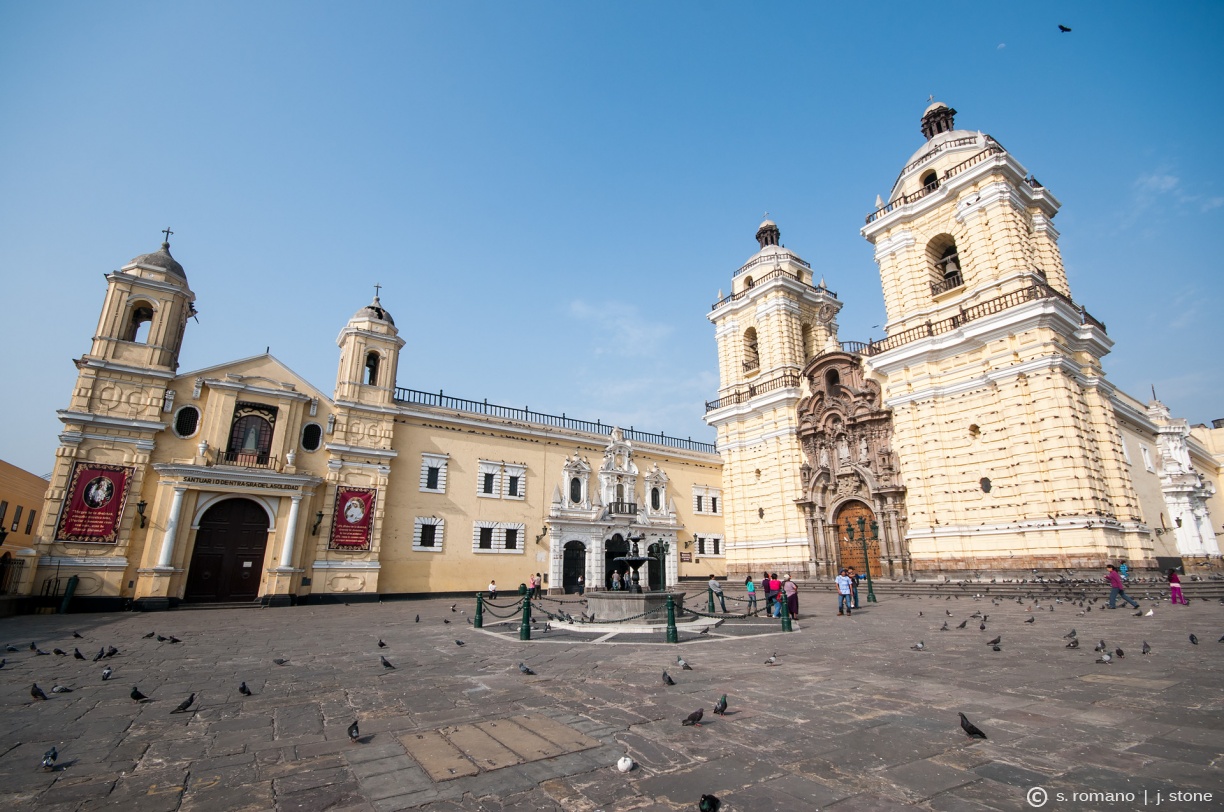On our way back to the U.S. from Cusco, we decided to spend a day and night poking around Lima. We wished we had more time to spend, as Lima and the surrounding areas seemed really interesting, but so it goes with limited holiday time (sigh…). Located on the central coast of Peru, Lima is the third largest city in the Americas with a population of almost 9 million. We hopped in a cab at the airport in Callao and headed for the historic center. Our first impression – the city was indeed enormous! Skyscrapers towered around us in every direction, and cars and taxis jammed the streets. The historic district is nestled in the northern part of the city, and is a stark contrast to all of the modern structures dominating the rest of the metro area.
We began at the Plaza Mayor (Plaza de Armas), which was surrounded with vibrant yellow buildings, each with fashioned with a series of arched windows and doorways. Across the square stood the Catedral de Lima and adjoining Archbishop’s Palace, an eye-catching residence with intricately-carved cedar balconies flanking either side of the entryway. On the adjacent side of the plaza, the Government Palace, the official office and residence of Peru’s sitting president, commanded the scene. While initially built in 1535, the stately headquarters have been remodeled numerous times, most recently in 1937. The building is elaborately styled, and tall, wrought-iron gates surround the complex.
Just across the street, right on the corner of the Government Palace, is a little hole in the wall called el Bar Cordano. One of the oldest bars in Peru, the establishment has been in business since 1905. Because of its location, it’s said that nearly every Peruvian president for the last 100 years has enjoyed a pisco at the small bar, as well as artists, writers, and dignitaries. Knowing we couldn’t leave Lima without experiencing the local gem, we headed over for a drink. The entrance is tucked in behind the façade of an unadorned building, with a simple sign above a pair of wooden and frosted glass doors. After entering, you are immediately struck by the historic charm, with the original floors and dark woodwork surrounding the bar. Stephan opted for the classic pisco sour, while I tried an algarrobina, a traditional drink made with a syrup from the black carob tree. We sipped our beverages and felt like we were now a small part of Lima’s history.
Before traveling to Lima, we had read about the catacombs at the Convento de San Francisco, a monastery that was constructed during the 17th century. Stephan was really interested in visiting the site, so we headed just one block east to check it out. The enormous, pale yellow, Spanish Baroque church and adjoining monastery soared above a modest stone plaza, and made you feel like you had stepped back in time to Old World Lima.
After touring the incredibly ornate interior of the church, filled with magnificent artwork that adorned the walls and ceilings, a beautiful hand-carved cedar staircase, and a staggering library, we descended below the chapel to view the catacombs. The vast chambers hold the remains of more than 25,000 individuals, who were interred beneath the monastery until 1808, when the public cemetery was opened. To construct the crypts, the Franciscans used brick and lime, which helped accelerate decomposition as well as prevent odors. The structure was also built to withstand earthquakes, which frequent the region. Inside the catacombs, numerous remains were arranged artistically in repeating circular patterns, using craniums, femurs, and bones of the lower leg. In some chambers, thousands of bones were sorted and piled on top of one another. In all, we found San Francisco to be incredibly fascinating – a tour of this dramatic church and intriguing burial site should not be missed (note: photography is not permitted at the site).
Later that afternoon, after a gorgeous day in the historic center, we grabbed a cab to Miraflores, a hip hotel district running along immense sea cliffs that descended sharply to the ocean below. We stopped at Parque del Amor, deciding to check out the park and take a walk along the cliffs. The park was quite lovely, with beautiful mosaic walls waving along the perimeter, mirroring the neighboring tide.
For our last night in Peru, we headed down to the beach to have dinner at La Rosa Nautica, a picturesque, Victorian-style building perched at end of a large pier that jutted out into the Pacific. The atmosphere was especially serene; the structure was washed with lights that glowed warmly in the settling fog, and the sound of the gently rolling waves was soothing after a busy day in the bustling city. While the food was tasty, though hardly as memorable as our amazing culinary experience in Cusco, the service was mediocre at best. The ambience was fantastic, though, and we enjoyed dining beside the large windows overlooking the water.










































